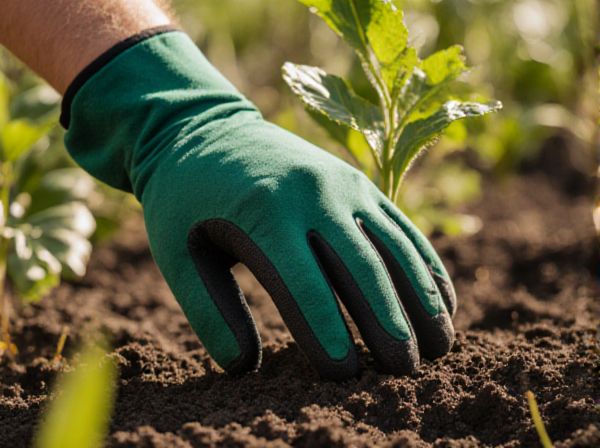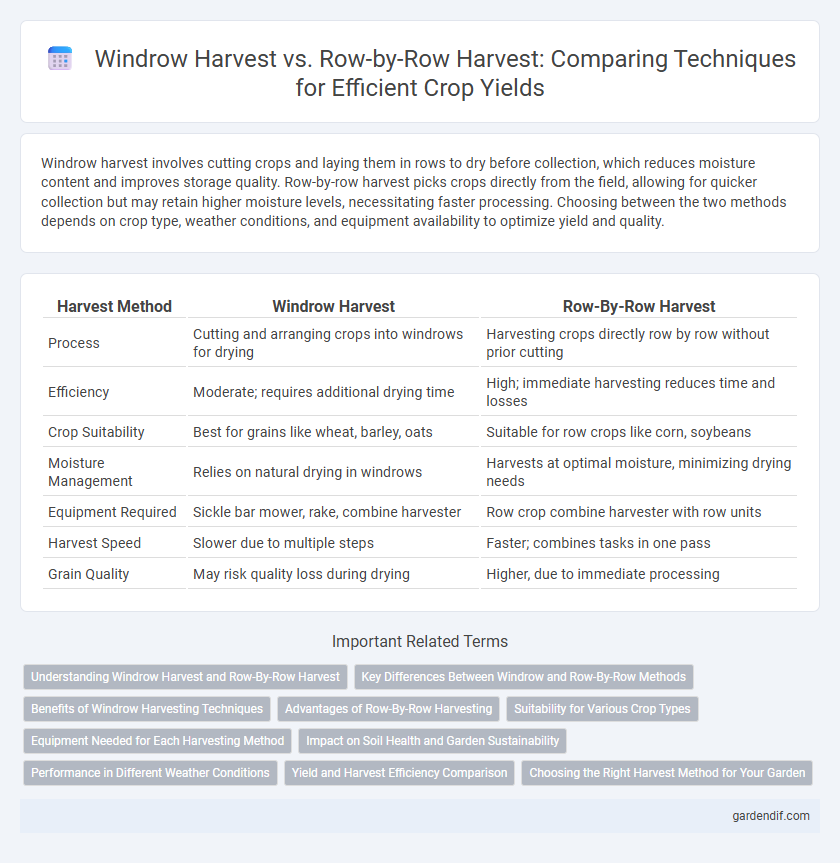
Windrow Harvest vs Row-By-Row Harvest Illustration
Windrow harvest involves cutting crops and laying them in rows to dry before collection, which reduces moisture content and improves storage quality. Row-by-row harvest picks crops directly from the field, allowing for quicker collection but may retain higher moisture levels, necessitating faster processing. Choosing between the two methods depends on crop type, weather conditions, and equipment availability to optimize yield and quality.
Table of Comparison
| Harvest Method | Windrow Harvest | Row-By-Row Harvest |
|---|---|---|
| Process | Cutting and arranging crops into windrows for drying | Harvesting crops directly row by row without prior cutting |
| Efficiency | Moderate; requires additional drying time | High; immediate harvesting reduces time and losses |
| Crop Suitability | Best for grains like wheat, barley, oats | Suitable for row crops like corn, soybeans |
| Moisture Management | Relies on natural drying in windrows | Harvests at optimal moisture, minimizing drying needs |
| Equipment Required | Sickle bar mower, rake, combine harvester | Row crop combine harvester with row units |
| Harvest Speed | Slower due to multiple steps | Faster; combines tasks in one pass |
| Grain Quality | May risk quality loss during drying | Higher, due to immediate processing |
Understanding Windrow Harvest and Row-By-Row Harvest
Windrow harvest involves cutting and arranging crops into rows or windrows to dry before collection, enhancing moisture reduction and ease of handling. Row-by-row harvest collects crops directly from their planting rows in a continuous process, maximizing efficiency and reducing field time. Understanding these methods helps optimize yield quality and machinery deployment based on crop type and field conditions.
Key Differences Between Windrow and Row-By-Row Methods
Windrow harvest collects crops into uniform rows or piles that dry naturally before threshing, optimizing moisture content and reducing the risk of grain spoilage. Row-by-row harvest involves cutting and processing each crop row individually, allowing precise control over yield and reducing damage to delicate crops. Windrow harvesting is typically faster and more suitable for crops requiring drying, while row-by-row methods offer better adaptability for varying field conditions and crop types.
Benefits of Windrow Harvesting Techniques
Windrow harvesting techniques improve crop drying by arranging produce into evenly spaced rows, enhancing airflow and reducing moisture content faster compared to row-by-row harvesting. This method increases harvesting efficiency by concentrating the crop into manageable windrows, allowing for quicker collection and reducing field passes, which minimizes soil compaction. Moreover, windrow harvesting supports better residue management, promoting soil health and facilitating subsequent field operations.
Advantages of Row-By-Row Harvesting
Row-by-row harvesting offers precise crop management by minimizing damage and loss compared to windrow harvesting, which often entangles plants and increases wastage. This method enhances yield quality through targeted harvesting techniques, preserving the integrity of individual rows and reducing contamination. Improved efficiency and flexibility in handling various crop types make row-by-row harvesting a superior choice for maximizing productivity and resource utilization.
Suitability for Various Crop Types
Windrow harvest suits crops like small grains, legumes, and forage grasses that require drying before threshing, offering efficient handling and reduced moisture content. Row-by-row harvest excels with row crops such as corn, soybeans, and cotton, enabling precise picking and minimizing crop damage. Selecting the appropriate method depends on crop structure, moisture tolerance, and harvest timing to optimize yield quality and operational efficiency.
Equipment Needed for Each Harvesting Method
Windrow harvesting requires specialized equipment such as windrowers or swathers that cut and lay grain in rows for drying before collection, along with combines designed to pick up the windrows efficiently. Row-by-row harvesting relies on precision combines equipped with row units that cut and thresh crops directly from each row, minimizing the need for prior crop conditioning. Choosing between these methods depends on crop type, moisture levels, and the availability of machinery tailored for windrowing or direct harvesting.
Impact on Soil Health and Garden Sustainability
Windrow harvest compacts crop residues into dense rows, enhancing decomposition rates and protecting soil from erosion while promoting moisture retention, which benefits soil microbial activity. Row-by-row harvest minimizes soil disturbance by gently collecting produce, maintaining soil structure and reducing compaction, crucial for long-term garden sustainability. Balancing harvest techniques with soil health goals ensures improved nutrient cycling and sustained productivity in garden ecosystems.
Performance in Different Weather Conditions
Windrow harvest excels in wet or humid conditions by allowing crops to dry naturally before combining, reducing grain moisture and improving overall yield quality. Row-by-row harvest performs efficiently in dry weather, enabling faster collection and minimizing field compaction with precise machinery movement. Choosing the appropriate method based on climate ensures optimal harvesting performance and crop preservation.
Yield and Harvest Efficiency Comparison
Windrow harvest collects crops in swaths, improving drying time and minimizing grain loss, which often results in higher overall yield compared to row-by-row harvest. Row-by-row harvesting offers precise crop handling and is more suited for uneven or mixed fields but may reduce efficiency due to increased machine passes and time spent per row. Yield outcomes and harvest efficiency are typically better in windrow harvest when managing large, uniform fields requiring accelerated moisture reduction.
Choosing the Right Harvest Method for Your Garden
Windrow harvest concentrates crops into narrow rows, speeding up drying and easing collection, ideal for large-scale operations or bulky crops like hay and grains. Row-by-row harvest allows precise picking, reducing crop damage and waste, beneficial for delicate vegetables and small garden plots. Selecting the right method depends on crop type, garden size, and equipment availability to maximize yield and efficiency.
Windrow Harvest vs Row-By-Row Harvest Infographic

 gardendif.com
gardendif.com